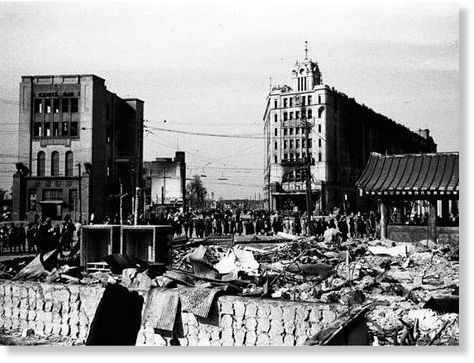
Views: 2378
On the 70th anniversary of Tokyo’s fire bombing, relatives are asking for a real tribute to its victims.
It was just after midnight when the rumble of B-29 bombers was heard, jolting Tokyo awake. The incendiaries that fell from their bellies, full of jelly petroleum, were like nothing anyone had ever seen.
They turned ca nals and rivers into flame and if the jelly stuck to you, it kept burning till flesh turned to bone. “The planes filled the sky like dragonflies,” recalls Michiko Kiyoka. “Everywhere you looked there were charred bodies.”
nals and rivers into flame and if the jelly stuck to you, it kept burning till flesh turned to bone. “The planes filled the sky like dragonflies,” recalls Michiko Kiyoka. “Everywhere you looked there were charred bodies.”
Today, Ms Kiyoka, now 91, will join a small group of elderly Tokyoites and mark the death of her father and sister in the 1945 firebombing, which killed about 100,000 people in the single night of 10 March.
Because men of fighting age were away, most of the victims were women, the elderly and children. A US survey later concluded that probably more people lost their lives during the raid by 300 bombers than at any single moment in history.
The Tokyo bombing opened the curtain on an orgy of destruction in the final months of the Second World War that included dozens of similar raids on Japanese cities, and culminated in the atomic bombing of Hiroshima and Nagasaki in August. When the droning of bombers stopped on 15 August, almost 70 cities had been reduced to rubble and perhaps half a million people were dead.
Some thought that Imperial Japan, like Nazi Germany, deserved retribution for the bombing of Shanghai and Chongqing, the Rape of Nanjing and other war atrocities across Asia. But others asked where had the moral high ground gone since US President Franklin D Roosevelt described the 1940 Nazi blitzkrieg of British cities as “inhuman barbarism”?
If the bombing of Dresden a month earlier than Tokyo had produced a ripple of public debate in Europe, “no discernible wave of revulsion took place in the US or Europe in the wake of the far greater destruction of Japanese cities”, wrote Mark Selden, a historian at Cornell University.
Yet today, unlike Hiroshima or Nagasaki, there is no publicly funded museum in Japan’s capital to commemorate the night of 10 March. The Tokyo government, urged on by a small group of private citizens, began compiling an incomplete list of victims in 2010. A small memorial squeezed into a corner of Yokoamicho Park in the city contains their names, next to a charnel house with the mixed ashes of thousands who died.
German Chancellor Angela Merkel today reminded Prime Minister Shinzo Abe of the need to face up to the past. In a speech in Tokyo, Ms Merkel said those who close their eyes to history are “blind to the present”, a quote from a famous speech by the late German president Richard von Weizsacker.
Tokyo lacked the emotional or financial resources to properly mourn the victims after the war, says Bret Fisk, a Tokyo-based novelist who writes about the 1945 raids. Later, there was no appetite for a political fight with Washington, Japan’s new Cold War ally. Remarkably, Japan awarded the architect of the 1945 raids, US General Curtis LeMay, its highest prize in 1964 for helping to reconstruct Japan’s Self-Defence Forces after the war.
Plans for a museum became bogged down in controversy in the 1990s. Conservatives said the plans were “anti-Japanese and “self-masochistic”. The decision infuriated survivors. Tokyo had no stomach for reminding people of the horrors of war, said survivor Katsumoto Saotome, who was 12 when the bombers arrived. He set up a private fund to build the Centre of the Tokyo Raids and War Damage, and helped launch a lawsuit for compensation. The suit was dismissed in 2009; government lawyers said that since Japanese civilians had equally experienced severe hardship during a time of national emergency, no particular group could receive special treatment, says Cary Karacas, a specialist on aerial bombing at the City University of New York.
The dwindling band of survivors of the Great Tokyo Air Raid met at the weekend to demand the event is properly memorialised. Mr Saotome says he accepts they face an uphill fight. He says that after all these years, he still doesn’t even like to say the say the figure of 100,000 people out loud – it’s too impossibly large.
“They were all individuals,” he said. “They had all been talking to their families hours before they died.”
Originally published on 2015-03-10
Author: David McNeill
Source: The Independent, UK
Origins of images: Facebook, Twitter, Wikimedia, Wikipedia, Flickr, Google, Imageinjection, Public Domain & Pinterest.
Read our Disclaimer/Legal Statement!
Donate to Support Us
We would like to ask you to consider a small donation to help our team keep working. We accept no advertising and rely only on you, our readers, to keep us digging the truth on history, global politics, and international relations.
FOLLOW US ON OUR SOCIAL PLATFORMS







